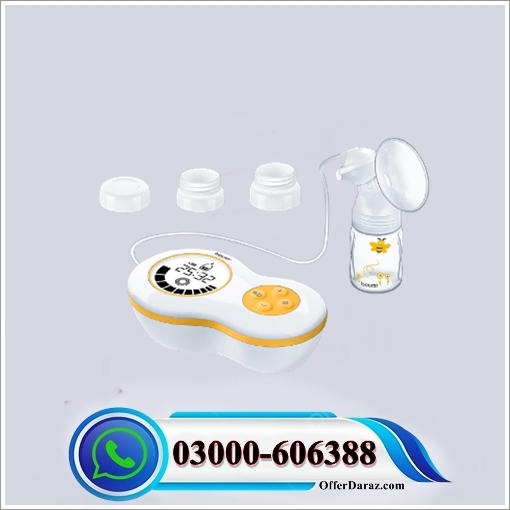Electric Breast Pump Price in Pakistan
Electric Breast Pump Price in Pakistan An electric breast pump is a mechanical device used by lactating women to extract milk from their breasts. It operates using electricity to power a motor that creates suction, making it much easier and less physically demanding than using a manual pump.
Function:
- Creates suction through a horn placed over the nipple, mimicking the baby’s sucking action.
- Expresses breast milk, allowing you to:
- Maintain milk supply when separated from your baby for extended periods.
- Store milk for later feeding by your baby or another caregiver.
- Prevent milk build-up and discomfort.
- Increase milk supply, if needed.
- Help babies with latching difficulties.
Operation:
- Powered by a motor, either plugged into an outlet or using batteries.
- Controls on the pump unit allow you to adjust suction strength and cycle pattern (mimicking let-down reflex).
- Some pumps have additional features like timers, memory settings, and portability.
Benefits:
- More efficient and less tiring than manual pumps.
- Allows for hands-free pumping.
- Adjustable settings for personalized comfort and effectiveness.
- Some models offer quiet operation, ideal for discreet pumping.
Considerations:
- Electric pumps can be more expensive than manual ones.
- Some models may be bulky or require additional parts, affecting portability.
- You need access to electricity or charged batteries for continuous use.
Choosing an electric breast pump:
- Consider your needs and pumping frequency.
- Evaluate features like portability, noise level, adjustability, and price.
- Consult with a healthcare professional for guidance based on your specific situation.
I hope this explanation helps! Let me know if you have any further questions about electric breast pumps or breastfeeding in general.
Benefits:
Electric breast pumps offer a variety of benefits for both mothers and babies. Here are some key advantages:
Convenience and Efficiency:
- Faster milk expression: Compared to manual pumps, electric pumps generally draw milk more quickly and efficiently, saving you time and reducing effort.
- Hands-free pumping: Unlike manual pumps which require constant hand use, electric pumps allow you to do other things while expressing milk, making it a hands-free experience.
- Adjustable settings: Most electric pumps have adjustable suction levels and cycle patterns, allowing you to personalize the pumping experience for maximum comfort and milk output.
- Quiet operation: Some models offer discreet pumping with minimal noise, suitable for late-night sessions or shared spaces.
Increased Milk Supply and Management:
- Maintaining milk supply: Regular pumping can help regulate and maintain milk production, especially when temporarily separated from your baby.
- Building a milk stash: Pumping allows you to build a stockpile of breast milk for later use, providing flexibility and peace of mind for work, travel, or unexpected situations.
- Engorgement relief: Pumping can help alleviate uncomfortable breast engorgement by emptying excess milk buildup.
- Support for low milk supply: In some cases, pumping can stimulate milk production and help increase low milk supply.
Other Benefits:
- Shared feeding: Pumped milk allows other caregivers to feed your baby, giving you a break or promoting bonding with partners and family.
- Early feeding for premature babies: Pumped milk can be crucial for providing essential nutrients to premature babies who may have difficulty latching.
- Dietary freedom: Pumping allows you to enjoy certain foods or medications that may otherwise affect your breast milk, while still providing your baby with the benefits of breastfeeding.
Side Effects:
Electric Breast Pump Price
- Nipple soreness and dryness: The constant pressure from the pump flanges can irritate the nipples, leading to tenderness, dryness, and even cracking. Applying moisturizers, using nipple shields, and adjusting suction strength can help alleviate this.
- Mastitis: In rare cases, improper hygiene or blocked milk ducts can lead to mastitis, an infection of the breast tissue. This requires prompt medical attention.
- Blocked ducts: Incomplete milk drainage can cause milk to clog in the ducts, resulting in lumps and pain. Warm compresses, gentle massage, and frequent pumping can help clear the blockage.
- Muscle aches: Prolonged pumping sessions can lead to muscle fatigue and soreness in the neck, shoulders, and back. Taking breaks, adjusting your posture, and using ergonomic pumps can help prevent this.
Milk Supply and Latching Issues:
- Overproduction: Frequent pumping can stimulate milk production beyond your baby’s demand, leading to oversupply and engorgement. Consult a lactation consultant to adjust your pumping schedule.
- Decreased milk supply: Using a pump instead of direct breastfeeding can sometimes decrease milk production over time. Combining pumping with latching can help maintain supply.
- Latching difficulties: Some babies may experience confusion between the nipple and the pump flange, making it harder for them to latch directly. Encourage direct breastfeeding whenever possible and consult a lactation consultant if needed.
Other Side Effects:
- Pump dependence: Over-reliance on pumping can interfere with the natural flow of milk during direct breastfeeding.
- Emotional stress: Pumping can sometimes feel tedious and impersonal, leading to feelings of guilt or inadequacy. Remember, breast milk is still valuable even if you can’t pump exclusively.
- Noise disturbance: Some pumps can be noisy, making them inconvenient for discreet or nighttime use.
Uses:
-
Early feeding for premature babies: As mentioned earlier, pumped milk can be crucial for providing essential nutrients to premature babies who may have difficulty latching.
-
Dietary freedom: Pumping allows you to enjoy certain foods or medications that may otherwise affect your breast milk, while still providing your baby with the benefits of breastfeeding.
-
Helping babies with latching difficulties: Some babies may have difficulty latching due to tongue ties, oral thrush, or other factors. Pumping can provide a temporary solution while the underlying issue is addressed.
Additional uses:
-
Helping babies who are not gaining enough weight: In some cases, babies may not be gaining enough weight through breastfeeding alone. Pumping can help ensure that they are getting enough milk to thrive.
-
Donating breast milk: Mothers who produce more milk than their baby needs can donate their milk to milk banks, which provide breast milk to babies in need.
- To begin with, an Electric Breast Pump offers a convenient and efficient way to express milk.
- Moreover, it can significantly reduce the time spent on pumping compared to manual methods.
- For instance, many models of Electric Breast Pumps come with adjustable settings for personalized comfort.
- However, it is essential to ensure proper cleaning and maintenance to ensure optimal performance.
- In summary, an Electric Breast Pump can be a valuable tool for busy parents looking to streamline their breastfeeding routine.




Humaira imtiyaz –
jab Kahi BAhir Jati Thi To Bacha Rota Tha Dodh NAhi De Sakti Thi Jab Sea AP Sea Pump Kharida Hy Ab Sakoon Hy Tention Hi NAhi HY Ab